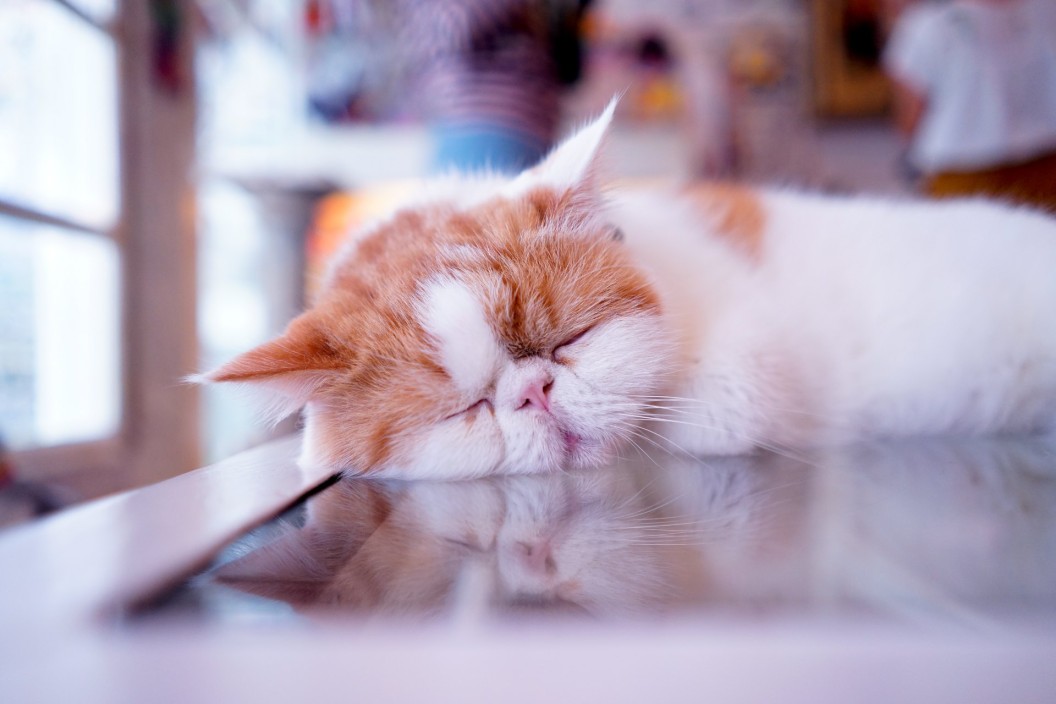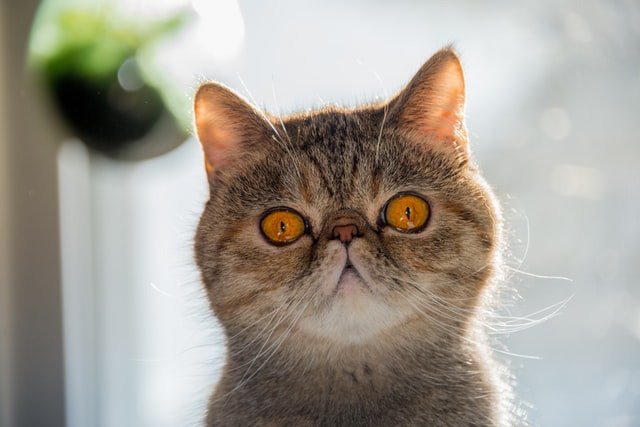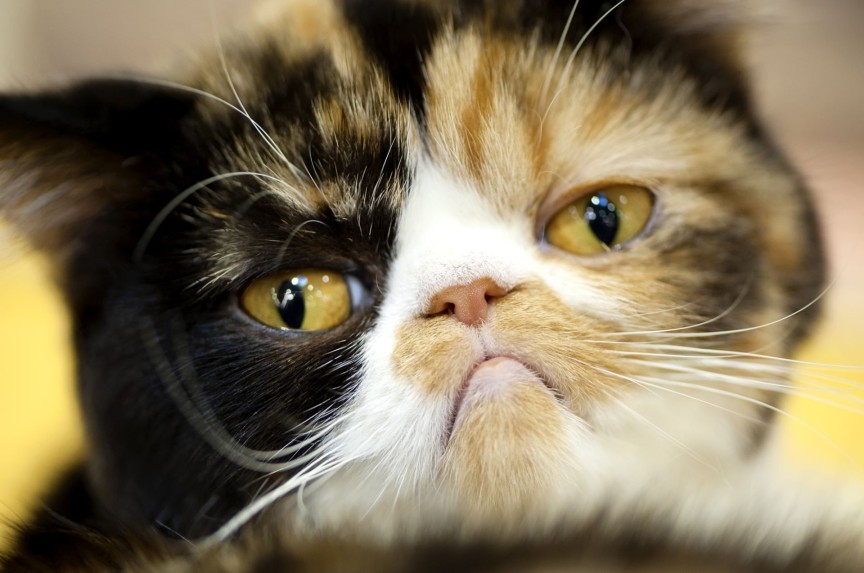
Exotic Shorthair
Posted: 02/14/2023 | BY: Content Writer
Exotic Shorthair Cat Breed Profile
Pet Profile
An easy going, intelligent and affectionate breed with teddy bear looks!
- Medium sized 23cm – 30cm
- Weight between 4kg and 5.8kg (9 – 13lbs)
- 12-14 years lifespan
The Exotic, sometimes called the Exotic Shorthair, is regularly named the most popular cat breed in the US. They look like Persian’s but without the long coat, and are affectionate, sweet cats.
This lovable breed, with its low maintenance, dense, short coat, and teddy bear appearance is popular with busy owners who don’t have the time to groom traditional Persian cats. Because of this, they are often called the lazy man’s Persian.
The exotic shorthair is an affectionate, calm, and loyal companion with an easy-going personality. They love a cuddle but are not demanding, and like playing games as much as the next cat. The males are particularly affectionate.
They originated in the 1960s and are the product of breeding American Shorthairs with Persian cats and adding a little Burmese and Abyssinian into the mix. They have short noses, round faces, big eyes, and short rounded ears.

History of Exotic Shorthair Cats
Exotic Shorthair Cats are a newer breed that came about in the 1950s when breeders mixed Persians with American Shorthairs to get the traditional look of a Persian cat except with a more manageable coat.
In 1967, the Cat Fanciers Association recognized it as an accepted breed. They are bred to the same breed standards as Persian cats, except with short hair.
Characteristics of Shorthair Cats
Exotic Shorthair cats are known to have teddy bear-like flat faces, short nose, and Persian traits.
These cats make great house cats and are suited for quiet homes and apartments. Exotic Shorthairs are mellow and calm and will seek attention from their favorite people.
They make a great feline friend for anyone with a busy life and are the perfect breed for a low-maintenance lifestyle.
Exotic Shorthairs have a sweet expression and a soft voice. Sometimes its pushed-in face is prone to tear staining under their round eyes.
Their coats are mat-free and shorthaired. Originally, they were silver, but today they can come in bi-colors, red tabby, and brown tabby too.
Adopting An Exotic Shorthair From A Cat Breeder Or Rescue
When searching for an Exotic Shorthair breeder, you want to find a reputable breeder and can see if they are recommended by the International Cat Association or Cat Fanciers Association.
You can sometimes find Exotic Shorthair cats from rescues or in shelters too.
Exercise And Nutrition of Exotic Shorthair Cats
Exotics are not big, but muscular and surprisingly heavy for their size. They tend to have shortish legs with a round, sturdy body but should not be fat.
If your Exotic lives indoors give them plenty of toys to play with and scratching posts to keep them exercised and healthy.
Their coat is thick so they will suffer from the heat, so make sure there is somewhere cool for them to sit in summer and they always have access to water.
Their short noses also make them more susceptible to the effects of heat so keep an eye on them in the summer and if you are at all worried, visit your veterinarian.
They need high-quality cat food, twice a day, fed according to your vet’s or the manufacturer’s instructions.
Their thick coat can make it tricky to judge if they are the right weight or overweight, but Obesity in Cats can be dangerous for their health so ask your veterinarian to advise you if you are at all concerned about your cat’s weight.
Common Health Problems And Illnesses Of Exotic Shorthair Cats
The breed is comparatively new, and early breeders were careful, so these cats are not particularly prone to genetic disorders.
However, they have a short face and big eyes so they can suffer from breathing and eye issues. The tear ducts can overflow, staining their fur but this can be cleaned with a damp cloth.
They can have sinus problems and occasionally might have teeth alignment issues because of their short jaw. If you’re at all worried about your cat’s health please consult your veterinarian. It’s worth taking out cat insurance when your cat is young so you can keep them healthy no matter what happens.
This disease causes lots of fluid filled cysts to form in the kidneys. An affected cat will have the condition from birth but when they are young the cysts will be small. As the cat grows the cysts increase in size and they eventually affect the normal function of the kidney.
In most cases the disease does not affect the cat until quite late in life, but it is fatal and most cats with the condition will die of renal failure.
The disease is inherited so it’s important to buy your Exotic from a reputable breeder who has had genetic tests completed to screen both parents for this condition.
This is a disease that a cat will develop if it has inherited the gene responsible from just one parent. With responsible breeding, this condition could be eradicated from the breed but currently, as many as 1 in 3 Exotic Shorthair kittens may have the condition.
Some Persians and Exotics have an early-onset form of PRA. They can start to lose their vision at around 5 weeks of age with severe loss of sight by 16 weeks of age. Many are blind by 20 weeks of age.
This genetic condition can be screened for, so only buy your Exotic from a breeder who screens both parents. If one parent has a genetic abnormality there is a 50% chance each kitten will either be a carrier for the condition or normal.
If both parents carry the mutated gene there will be a 25% chance of their offspring developing the condition and 50% chance of their offspring being carriers.
This is the most common inherited heart disease suffered by cats. Persians and so Exotics are particularly prone to the condition. It is possible to screen breeding cats for this genetic condition so buying from a breeder who screens their breeding cats in always a good idea.
Symptoms include difficulty breathing or fast breathing, weight loss and extreme lethargy, and limb paralysis from blood clots in the hind limbs. It is often difficult to tell if your cat is struggling as they are good at hiding illness, but if you are at all worried consult your veterinarian.
The condition can be fatal but it can be diagnosed using an echocardiogram. There are medications that can help the condition and the treatment plan will depend on the cat’s symptoms.
There are drugs to prevent blood clots, diuretics if the cat is in heart failure, drugs to bring down blood pressure, medication for heart muscle disorders and to control an irregular heartbeat.
Early diagnosis is crucial to improve a cat’s quality of life and life expectancy, so don’t ignore your instincts if you think your cat is struggling.
Fun Facts About Exotic Shorthairs
- Exotic shorthair cats are heavy, but they’re usually not fat, just heavy-boned – really! They have short legs big heads and wide necks and their bones are very dense.
- With adorable teddy bear looks, they’re a favorite for movies and tv. In the Cats and Dogs movies, the evil Mr. Tinkles has a sidekick called Calico, who is an Exotic.
- Cute internet favorites Pudgethecat (who has 675,000 followers) and Snoopybabe (who has 361,000 followers) prove no one can resist an Exotic.
- Exotics are definitely not grumpy despite the way they look!
